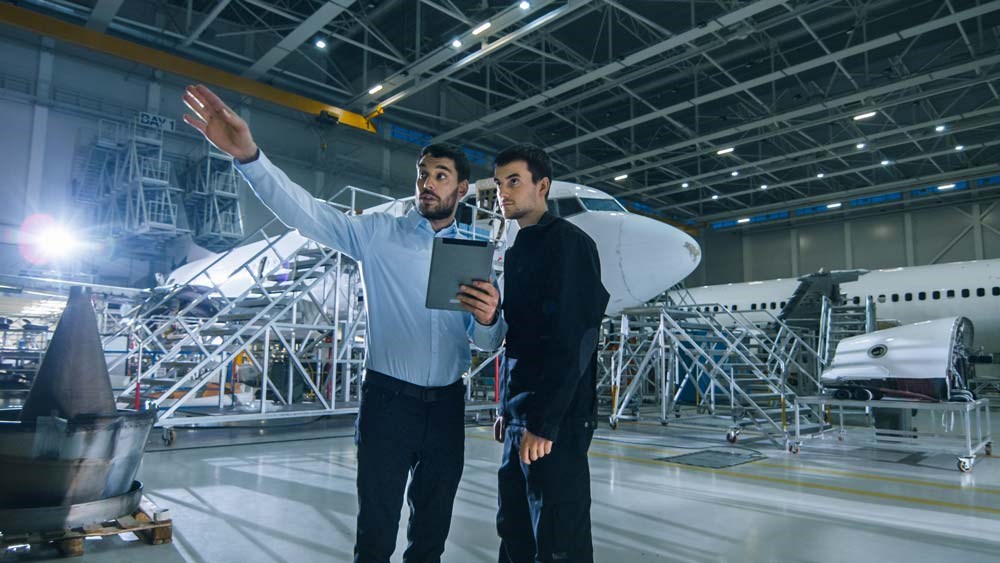Successful implementation of new technologies starts with an executive decision, but it shouldn’t end there. People perform best when driven by inspiration and it’s the management's responsibility to generate organisational buy-in for new ideas. But how do you foster this environment? Listen in, as top aviation executives share their experience.
In today's globalized world, remaining static and trusting that the “good old ways” will prevail just isn’t an option. If you don’t innovate, you lose – and this is as true for the aviation industry as it is for any other industry.
Why keeping up is essential
History provides us with numerous examples of companies who failed to innovate, ultimately leading to their demise. One example of this is the American home video provider Blockbuster, which had enormous success in the late ’90s and early 2000s. However, the company failed to embrace new technological innovations, trusting their business model and core product.
We’re all familiar with what happened next. Netflix disrupted the market with a new way of providing home entertainment, now commonly known as online streaming, which ultimately led to Blockbuster filing for bankruptcy in 2010.
Executives on how to embrace change
The importance of innovation isn’t breaking news to executives. Unfortunately, though, innovation comes with a certain amount of risk and this roll-of-dice element is what’s making executives in the aviation industry hesitant to change. The majority prefer to wait until other companies have tested the new waters, allowing them to bear the risk and take the potential fall – or the enormous success – inherent in every innovation.
At MRO Europe 2018, a group of executives sat down to discuss new technologies and their experiences with driving organisational change. Forming the basis of the discussion were three things that all companies successful at adopting new technologies and tools have in common:
- They foster innovative environments to improve further
- They carefully choose innovations that match their organizational strengths
- They are able to motivate vital team members and generate the buy-in necessary for success

LEARN MORE:
Five emerging technologies that will change the MRO industry
How do you foster technological innovation in your organisation?
According to Tristan Whitehead, CEO of Parts Pedigree – a next-generation aerospace supply chain platform – »the hard stuff is the soft stuff.«
By this, he means technology breakthroughs themselves are not the most difficult part, rather fostering a culture of innovation that leads to such a breakthrough is. So what can be done to create more innovative environments in our respective organisations?

According to Arjan de Jong, Principal in the Netherlands Aerospace Centre, fostering innovation depends on a systematic approach to future forecasting that involves seeking out potential problems and breaking them up into actionable parts. At the Netherlands Aerospace Centre, they do the following:
»One of the first steps we take when we start to think about innovation is to sketch a picture of the future. We look at the developments that will occur in society, in technology and with the environment, and we’ll make scenarios of potential future developments. These developments will give us an idea of where the problems are. One of the problems we see, at this moment, is a shortage of manpower in aviation, especially on the MRO side. Once we know what the problems are that are coming our way, we can put dots in those areas and say those things need solutions, and once we have an idea of those problems, we’ll break it up into smaller problems we can actually solve, « he says.
One of the main things, he notes, is approaching innovation in small steps that the organisation can actually achieve.
»We’ll start off with very incremental things —small steps, small demonstrations of where we are at the moment. We’ll start off at a low technology readiness level, showing concepts, then moving on to demonstration and prototypes. When we have all the prototypes, we can actually assemble them and create a new innovation,« he continues.
According to Loh, the main way to push innovations through at his organisation all comes down to whether or not they can delight their customers. At Singapore Technologies Aerospace, they ask themselves two questions every time they innovate:
- How we can we use technology to standardise the systems that we have and improve efficiency so that we can we can satisfy the customer at a lower cost?
- How we can we use technology to have a seamless connection between us and the customer?

LEARN MORE:
A group of leading OEMs discuss next generation engines and future challenges
How do you focus your innovations?
With so many new technologies out there, a burning question remains: which ones should you implement in your own organisation?
For de Jong, the key is focusing on potential benefits and organisational strengths.
» For every innovation that we develop, we ask ourselves whether or not we’re going to make somebody happy with it. I don’t know if there is a market for it, or if there is really a problem. It’s driven by productivity, cost-effectiveness and competitiveness. Another aspect is that it must be something we are capable of doing, something within our scope, something where we can contribute to the development. We stay with what we’re good at and pick our specific innovations,« he explains.
For Birkan Güneralp, SVP of Quality Assurance at Turkish Technik, the goal is doing more with less.
»We are trying to do more with what we have existing. We’re just planning better, making post analysis better, so it can enlighten us better in terms of customers,« he says.
Getting organisational buy-in
Just because implementing a certain technology or innovation can offer benefits doesn’t mean your organisation will necessarily be ready to adopt it. A huge concern when talking about new technologies is how to get stakeholders to make the switch.
Here, Whitehead makes a good point:
»Make friends with somebody who is very close to the office of the CFO. If you are doing business cases, get someone from the CFO’s office on your team, so you have that person plugged into your regular team meetings. That way, when that business case hits the desk of the CFO, there are no surprises, all of the numbers are rock solid and nobody can pick it apart,« he explains and continues:
»Everyone knows who the informal leaders are in the business. They’re the guys that don’t have the fancy titles, but when you ask the technicians they always know whom to go to and they follow these individuals. Those are the guys that you need to tap into and bring onto your team. Often times the rest of the workforce is looking for a signal that this guy approves.«
Güneralp agrees.
» Management plays the biggest role, but I would say the technicians are playing the crucial role because they’re the ones that will be using it. If they see a benefit in something, they stick with it. It’s all about explaining it to them – not by email or letter – but by working together with them, right next to them, on the hangar level. They have to understand that this new stuff is a benefit for both them and the company,« he says.

What are the risks of implementing new technologies?
Every time you implement new technologies, there are always risks. Openness to failure is another trait that all innovative organisations have in common, but how do you create openness to failure in large organisations accustomed to insulating themselves from failures?
For many panellists, openness to failure had to do with the organisation collectively agreeing that the innovation was beneficial and worth trying.
»I think the buy-in by the people all the way down to the last technician on the floor is very important because if not, you just become the flavour of the month, « says Loh.
For Güneralp, it wasn’t so much the risk of failure that was a concern, but the risk of not moving forward.
»Because of how slow the aerospace industry has been to adopt new technologies, compared to other industries, everything has pretty much been tried somewhere else as a result. If aerospace has adopted something, unfortunately, it’s already been adopted by another industry. I wouldn’t say there’s too much risk of being affected negatively, but there’s a bigger risk of not catching up with the current technology,« he explains.
As Whitehead notes, though, large organisations don’t necessarily always have the luxury of applying the fail faster mindset of start-ups. They very often have to consider risk mitigation and regulatory compliance.
According to de Jong, though, »if you take small steps you can mitigate a lot of risks and comply with whatever regulation you face,« he says and ends the debate with a strong message:
»When it comes to innovations, perhaps the biggest risk is not taking any risks at all.«